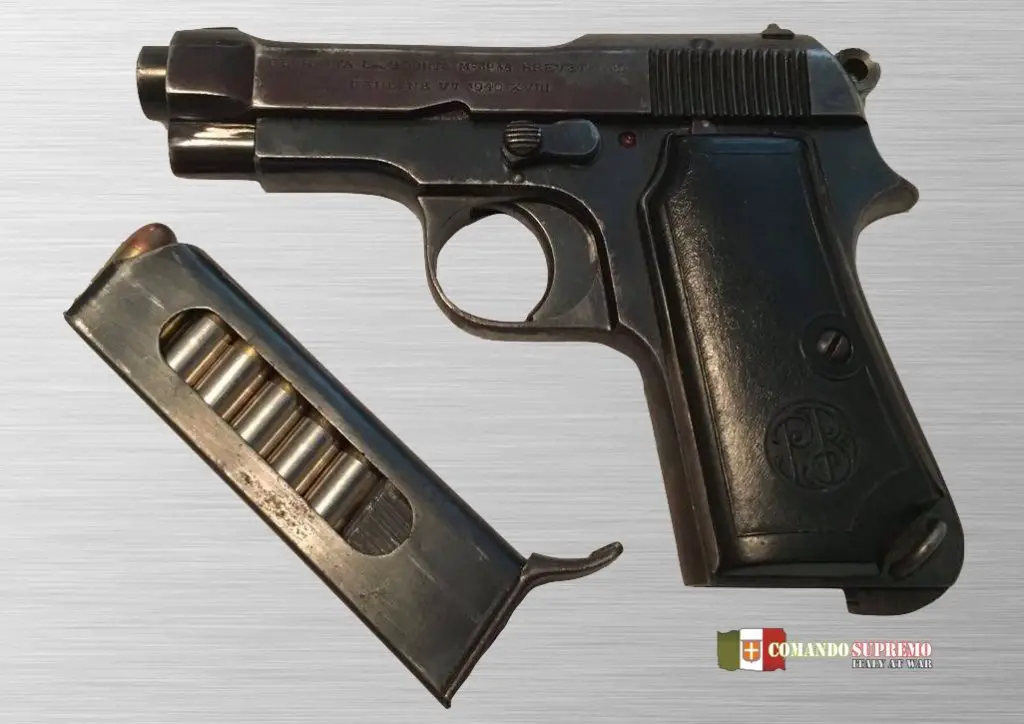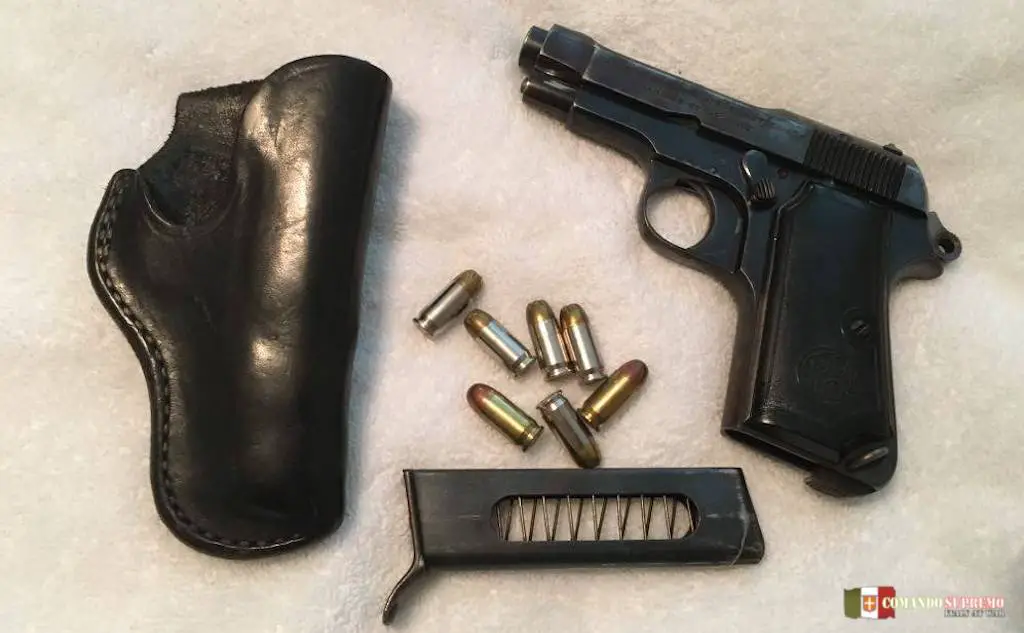The Beretta M1934 is a semi-automatic service pistol used by the Italian armed forces starting in 1935. The weapon fires 9mm rounds or .380 APC. Beretta built over one million of these pistols before ceasing production in 1991.

Beretta M1934
Origin and development
In 1933, the Italian Ministry of the Interior desired to re-equip the police force with a new side weapon. The famous Italian weapons manufacturer, Beretta, active since 1526, subsequently obtained the contract.
Requirements
The ministerial request called for a small weapon with minimal bulk and utilizing simple, yet reliable parts. Its cartridge should have good stopping power but also be cost-efficient.
Beretta weapons designer Tullio Marengoni designed a gun that not only represented the evolution of the previous Beretta gun, the M1931, but also the final development of the design process that started with M1915. The M1915 sidearm equipped most of the Regio Esercito during the Great War.
Beretta M1935 Variant and Rounds
The new gun, the Beretta M1934, was simple, reliable, and robust. It utilized the 9x17mm (.380 ACP) round, known in Italy as the 9 mm Corto, or “Short”. Additionally, Beretta developed a version chambered to fit the 7.65 mm Browning (.32 ACP) cartridge. This version became known as the Beretta M1935 and was adopted by the Regia Marina and Regia Aeronautica.
Safety Slide
The Regio Esercito requested that Beretta introduce a Walther-style slide safety, similar to the one located on the Walther PP. Beretta, lamentably, worked on the request and produced about a hundred guns with this Walther style safety. However, when Beretta informed the army of the increased production costs, the Regio Esercito decided to revert to the original design. This process caused a delay which delayed the Regio Esercito from adopting the gun until 1936.
Although the M1934 met expectations, critics claim the cartridge choice did not put the gun on equal terms with other foreign competitors. However, the decision in using this lower performance cartridge was based on both technical and economic reasons. Simply put, it was cheaper to make.
The pistol encompasses 39 total parts and designed so that it could be manufactured with the least number of mechanical procedures. In fact, the production process for this weapon is far less than a vast majority of other pistols of the time. However, the simplicity of the M1934 did not reflect its quality. It has good precision, even in the hands of novice shooters.
Exports and Service History
The Regio Esercito absorbed most of the pre-war and wartime production of M1934. Romania also imported 40,000 examples in 1941, and Finland received roughly 6,000 in 1942. Sales of the weapon also occurred in the civilian market, but numbers are uncertain.
Initially, the pistol was assigned to officers and members of select troops before becoming more widespread. The M1934 (and M1935) saw action on all fronts where Italian armed forces fought in World War Two. It proved to be extremely reliable in any climate.
Allied soldiers also appreciated M1934. They looked at this Italian pistol as a valuable prize, just as they did the German Luger or Walther pistol. Because Beretta factories were located in German-occupied areas in northern Italy between 1943-1945, soldiers in the area were issued the handgun. The Germans classified these guns as Pistole 671.
Production and End of Service

A Beretta M34 from a private collection.
After the war, the M1934 remained in service with the new Italian armed forces, including the Carabinieri. However, it became progressively obsolete, and the Italian Army replaced the M1934 in the early 1970s with the new Beretta M51. The Carabinieri continued utilizing the M1934 until 1981, the same year that military production ended. Beretta manufactured a total of approximately 1,080,000 pistols. Production of the M1935 ceased in 1967 after delivering 525,000 pieces.
Serial Numbers
The following serial numbers apply to the production year. Note: M1934s manufactured in 1991 were for the civilian market.
1934 – 1942 – from about 500073 to 999996
1934 – 1942 – from 1 to about 40000
1943 – 1945 – from F00001 to F99997, G00001 to G57486, 0001AA to 9997AA, and 0001BB to 9971BB
1946 – 1949 – from C00001 to C99998
1949 – 1954 – from D00001 to D99999
1954 – 1967 – from E00001 to E95760
1967 – 1973 – from F50001 to F61693
1970 – 1975 – from G00007 to G49620
1972 – 1974 – from H00001 to H25000
1971 – 1980 – from T 1 to T 10217
1991 onwards from A28530Y
Death of Mahatma Gandhi
It is worth noting that the Beretta M1934 has an interesting thing in common with the Carcano M91/38 rifle. Each of these weapons was involved in very famous assassinations.
Most people are aware that President John F. Kennedy was killed by a Carcano on 22 November 1963. But on 30 January 1948, Hinduist extremist Nathuram Godse, used an M1934 pistol to assassinate Mahatma Gandhi. The origin of this particular gun is still under debate but likely became acquired by Commonwealth forces during the East African campaign of 1940-1941.
Specifications
| Specification | Beretta M1934 |
|---|---|
| Production year | 1934-1991 |
| Total Units | 1,080,000 |
| Weight | 1 lb 7 oz (660 grams) |
| Length | 6 in 152 mm |
| Barrel Length | 3.7 in (94 mm) |
| Cartridge | .380 ACP 9 mm Corto |
| Action | Blowback |
| Muzzle Velocity | 750 ft/s (229 m/s) |
| Feed System | 7 + 1-round detachable box magazine |
Sources
Riccio R., Tactical-life.com
exordinanza.net
Mc Collum, I., forgottenweapons.com